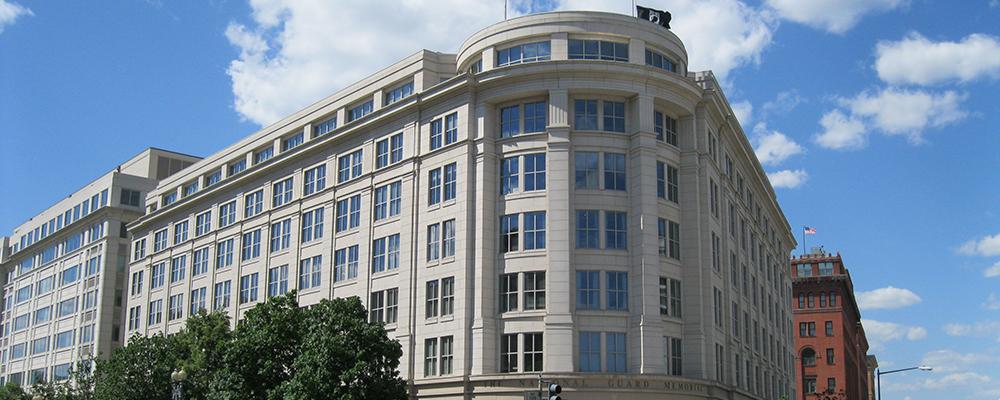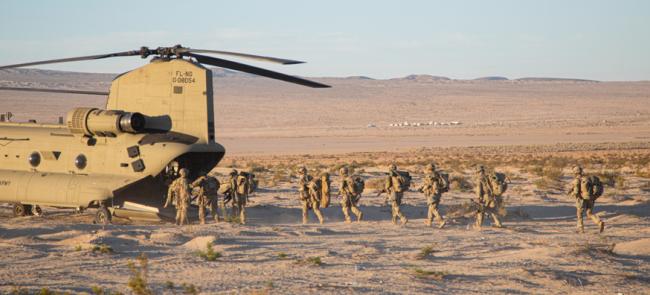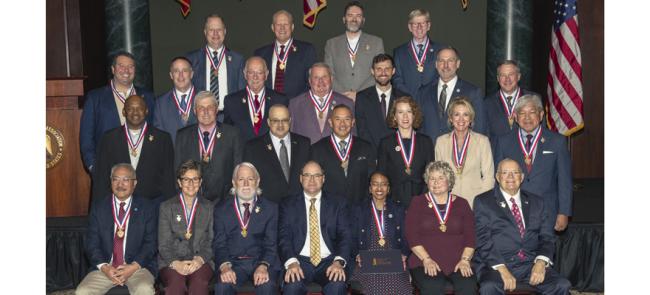
What Has NGAUS Done for You Lately?
A whole lot. But recent victories are only the latest in a long list of legislative accomplishments.
2020
Some new benefits and greater eligibility for some existing veterans’ programs top NGAUS accomplishments.
The new benefits include paid maternity leave for drill-status women. The intent of the program, which the Pentagon has not yet implemented, is to provide excused absences with pay and retirement points for up to three months of unit training assemblies.
Also included in the fiscal 2021 National Defense Authorization Act is six months of transitional medical coverage for Guardsmen and their families after Title 32 coronavirus response missions.
Meanwhile, the Johnny Isakson and David P. Roe M.D. Veterans Health Care and Benefits Improvements Act of 2020 credits for the first time service under Title 32 toward Department of Veterans Affairs home loans.
Additional language extends federal employment protections and reemployment rights to Guardsmen who serve at least 14 days of state active duty or who are mobilized to respond to a national emergency or natural disaster.
NGAUS also won some major equipment battles in 2020. One of the most significant is the six C-130J Super Hercules cargo planes for the Air Guard. There are also 43 new or rebuilt UH-60 Black Hawk helicopters along with $100 million in the Humvee modernization program for the Army Guard.
Finally, a provision in the NDAA adds the National Guard Bureau chief to the list of senior officers able to provide an unfunded priorities list to Congress.
2019
The final required major benefit fix to mobilization authority 12304b tops a strong year of accomplishments.
Congress created the new authority in 2012 to give the services easier access to the National Guard and Reserve for preplanned missions. But it lacked the personnel benefits provided by other authorities, including premobilization and transitional health care and credit toward the GI Bill and early retirement.
Adding the three benefits was a NGAUS priority for four years.
The association also convinces lawmakers to include a provision in the fiscal 2020 NDAA that opens TRICARE Reserve Select in 2030 to Guardsmen and Reservists to dual-status technicians and other full-time federal employees currently prohibited from purchasing TRS.
NGAUS is also instrumental in getting 64 new UH-60M Black Hawk helicopters for the Army National Guard and four new C-130J Super Hercules cargo planes for the Air Guard in fiscal 2020 legislation.
In addition, lawmakers for the sixth consecutive year add $100 million to the budget to rebuild Humvees. They also provide $395 million each for the Army and Air Guard in the National Guard Equipment and Reserve Equipment Account.
Unfortunately, the Pentagon later reprograms the Humvee and NGREA funding along with two of the C-130Js from fiscal 2020 appropriations.
2018
NGAUS convinces Congress to add language to the fiscal 2019 NDAA that authorizes the service secretaries to adjust the effective of date promotion for Guard officers who experience undue delays in getting federal recognition of their state promotions.
Another provision requires the Army and the Air Force to report to Congress on how they intend to accelerate federal recognition process. With lawmakers focusing the issue, average Fedrec wait times drop from 293 days in March to 175 days in October.
2017
Bringing the benefits Guardsmen and Reservists receive under 12304b in line with other mobilization authorities tops the NGAUS legislative priorities for the formulation of the fiscal 2018 defense bills.
The Harry W. Colmery Veterans Educational Assistance Act of 2017, also known as the Forever GI Bill, extends the Post-9/11 GI Bill to 12304b. It also eliminates the expiration date on benefits for anyone who left the military after Jan. 1, 2013.
And the fiscal 2018 NDAA provides predeployment and transitional TRICARE health coverage to those on 12304b orders.
2016
Among the association’s victories is a change in the federal definition of veteran to include all Guard and Reserve retirees. The old definition limited veteran status to those who served more than 179 days on federal active duty for other than training.
NGAUS also works with Congress to pass legislation recognizing the remotely piloted aircraft mission as aeronautical under the Federal Aviation Administration definition. The change enables Air Guard RPA units to remain eligible for low- or no-cost leases at civilian airports.
2015
NGAUS supports successful efforts in Congress to prohibit the retirement of A-10, which it believes has no peers in close-air support.
2014
The association works with Congress to establish the National Commission on the Future of the Army. Evaluating the Army’s controversial plan to transfer all of the Army Guard’s AH-64 Apache attack helicopters to the active component is among the commission’s assignments.
In addition, lawmakers, at NGAUS urging, remove the requirement that the 90 days of active-duty service associated with the early retirement program be performed in a single fiscal year. However, it only applies to activations beginning in fiscal 2015 or later.
2013
The fiscal 2014 NDAA includes increased procurement of UH-72 Lakota helicopters, requires a Defense Department report on the Guard’s role in Cyber Command and cyber operations, and places limits on canceling Guard deployments.
2012
Spurred by NGAUS, Congress beats back most of the personnel and aircraft cuts the Air Force wanted to take from the Air Guard. And to ensure more transparency and Guard input in the development of future budget requests, lawmakers, at the association’s urging, establish the National Commission on the Structure of the Air Force, which would study the appropriate force-structure mix — active, Guard and Reserve.
NGAUS also leads the charge against a recommendation by the 11th Quadrennial Review of Military Compensation to cut drill pay in half. The proposal ends up dead on arrival when it reaches Capitol Hill.
2011
The association overcomes strenuous Pentagon opposition to score one of the Guard’s biggest legislative victories in a century — a seat for the NGB chief on the Joint Chiefs of Staff.
2010
Congress corrects oversight in the Post-9/11 GI Bill to ensure Guardsmen who perform homeland security missions in a Title 32 status would be eligible for the new education benefits.
2009
Extending the availability of TRICARE medical coverage to gray-area retirees tops several NGAUS accomplishments. Others include an increase from 90 to 180 days the time a Guardsman or Reservist is eligible for TRICARE coverage prior to mobilization.
2008
The association wins the largest increase in Army Guard Active Guard Reserve positions (2,110) in 22 years. NGAUS also convinces Congress to increase controlled grades for the Army and Air Guard and expand Department of Veterans Affairs’ health care for rural veterans.
In addition, lawmakers enhance protections against deployment foreclosures and mortgage interest-rate hikes and pass a new GI Bill for recent veterans. The Post-9/11 GI Bill covers tuition, housing and books. It’s also the first GI Bill to allow service members to transfer benefits to family members.
2007
The association convinces Congress to extend to 10 years the time limit for mobilized Guardsmen and Reservists to use their education benefits, and increase from 90 to 130 the amount of points per year that are applicable to a reserve retirement.
Lawmakers also reduce the age some Guardsmen and Reservists are eligible for retirement pay. For every 90 days of active duty, they will receive retirement three months earlier. However, early retirement covers service only from January 2008 forward.
2006
Congress streamlines several different TRICARE programs for part-time Guardsmen and Reservists into TRICARE Reserve Select. For the first time, every traditional Guardsman and Reservist is eligible for low-cost health coverage. The victory culminates a seven-year NGAUS effort to improve the Guard’s medical readiness.
2005
NGAUS becomes the focal point for opposition to the 2005 Pentagon’s Base Realignment and Closure recommendations to ground 29 Air Guard flying units. Most of the units survive. The association also helps win more than $1 billion in congressional add-ons.
2004
Congress agrees to permanently provide Guardsmen and Reservists access to TRICARE 90 days prior to mobilization and 180 days after separation. In addition, lawmakers approve a measure that allows the defense secretary to provide states with funds to employ Guardsmen for domestic missions under Title 32 for up to 180 days.
2003
NGAUS convinces Congress to overcome strenuous Pentagon objections and provide the first major expansion of TRICARE coverage to the Guard and Reserve. While only temporary, it provides access to coverage 60 days before mobilization and 180 days after separation. The measure also offers low-cost coverage to part-time Guardsmen and Reservists, who don’t have employer-provided coverage.
Lawmakers, at the association’s request, make VA home loans for Guardsmen and Reservists with six years of service a permanent benefit. They also approve unlimited use of commissary stores on military bases and concurrent receipt for those with disabilities of 50% or more.
2002
Lawmakers expand the Soldiers and Sailors Civil Relief Act (now called the Servicemembers Civil Relief Act) protections to Guardsmen mobilized under Title 32 for more than 30 days.
2001
The association convinces Congress to give disability coverage to Guardsmen injured overnight within normal commuting distance to their homes.
2000
Congress increases the maximum number of retirement points per year from 75 to 90 and extends several special pays, bonuses and benefits, at NGAUS request.
The association is also among several military and veterans service organizations that convince lawmakers to provide TRICARE for Life eligibility to all Medicare-eligible retirees of the uniformed services and their family members.
1999
At the association’s behest, Congress creates a Thrift Savings Plan for the Guard and Reserve, opens the TRICARE Dental Program to family members, and extends VA loans to the Guard and Reserves for eight more years.
1998
Congress provides imminent danger pay comparable to the active component.
1996
Lawmakers, at NGAUS request, thwart cuts to Army Guard divisions and a proposal to reduce aircraft authorized from 15 to 12 in the Air Guard’s general-purpose flying units. Personnel successes include increases in available retirement points for all Guardsmen and retired credit for time served in the ROTC as part of the simultaneous membership program.
1995
The association leads efforts to defeat Guard military technician cuts under President Bill Clinton’s Reinventing Government proposal. Congress directs that force structure dictate any future military technician cuts.
1994
NGAUS turns away an attempt to apply across-the-board civilian cuts to the Guard’s full-time force as well as Pentagon proposals to reduce funding for new equipment and personnel benefits.
Congress also authorizes burial of retired Guardsmen and Reservists at any VA cemetery. It also approves the Uniformed Services Employment and Re-employment Rights Act, which overhauls, clarifies and improves the 1940 veteran’s re-employment rights law.
1992
The association convinces Congress to halt Pentagon plans to cut 48,100 Army Guard troops. Lawmakers also fund a Guard pilot program to work with at-risk youth in 12 states called Youth ChalleNGe, and authorizes a seven-year program to provide VA home loans to Guardsmen and Reservists with six years of service.
1991
Operations Desert Shield/Storm move Congress to authorize several personnel benefits for Guardsmen, including a basic allowance for quarters for single members without dependents, payment of medical special pay at active-duty rates and a variable housing allowance upon mobilization.
1987
NGAUS persuades Congress to make permanent the Montgomery GI Bill.
1986
Lawmakers pass the Montgomery Amendment to protect the Guard’s overseas training program.
1984
The Montgomery GI Bill provides, for the first time, federal financial support to Guardsmen going to college. It’s named after principal Capitol Hill sponsor, Rep. G.V. “Sonny” Montgomery, a retired Mississippi National Guard major general.
1983
Congress directs DoD to test year-round commissary access for the Guard and Reserve.
1982
NGAUS wins passage of civil-service retirement disability pay to Guard technicians separated from their jobs due to a physical inability to maintain drilling membership. Congress also clarifies its intent to have the Guard AGR personnel under state control.
1981
Lawmakers, at the association’s request, reject a proposal to cut military retirement pay for federal employees. In addition, the fiscal 1982 defense budget includes, for the first time, a separate congressionally directed account for Army Guard equipment. The National Guard and Reserves Equipment Account will eventually include funds every year for each of the reserve components.
1979
Congress authorizes pay for simultaneous membership in ROTC and the Army Guard.
1978
Lawmakers approve a test of full-time manning in AGR status in addition to military technicians. Other victories include passage of a Survivor Benefit Plan and re-enlistment bonuses.
1976
Congress passes legislation to allow the presidential call-up of 50,000 Guardsmen and Reservists without declaration of a national emergency.
1973–1975
NGAUS focuses on bolstering Guard benefits to improve recruiting and retention in the new all-volunteer force. Among the victories are housing allowances for new Guardsmen under the Reserve Enlists Program, group life insurance coverage, authority to withhold premiums from drill pay for state-sponsored insurance, burial flags and some access to space-available travel.
1968
Congress passes and the president signs the National Guard Technician Act. This closes a 10-year NGAUS effort to bring more than 40,000 Guard full-time technicians into civil-service status.
1961–65
The association neutralizes another Pentagon effort to reduce Army Guard personnel end-strength and eliminate four combat divisions. The association also helps defeat a DoD proposal to reduce defense spending by cutting Guard and Reserve pay tables to 75% of the active component’s.
1960
Public Law 86-632 clarifies re-employment rights and job protection for Guardsmen preforming an initial period of active duty for training for up to six months. In addition, NGAUS, with the help of supporters in Congress and the governors, beats back a Pentagon proposal to fold the Army Guard into the Army Reserve.
1959
Lawmakers grant national cemetery burial rights to Guardsmen who die during training, during travel to and from training or while under treatment for injuries and illnesses contracted while training or traveling.
1956
Public law 845 authorizes female officers in the Guard. Public Law 881 generally increases benefits for survivors of deceased Guardsmen.
1954
Public Law 477 culminates a long fight to obtain official active-duty status for U.S. Property and Fiscal Officers in every state.
1950
Congress approves the first armory construction bill. It provides federal funds amounting to 75% of the cost of new armories on state land and 100% if the facility is needed due to federal force-structure changes.
1948
Public Law 810 provides Guardsmen and Reservists their first comprehensive retirement benefits.
1944
Maj. Gen. Ellard A. Walsh, the NGAUS president, helps defeat Army and War Department plans to relegate the Guard to a state-only role after World War II with no part in plans for a separate air force. His speeches, articles and letters to major newspapers and magazines expose the effort, undertaken while 18 Guard divisions fight overseas.
1933
A NGAUS-drafted amendment to the National Defense Act streamlines the Guard’s transition between state and federal status by creating the National Guard of the United States. Guardsmen are now simultaneously members of two separate organizations: their state Guard and NGUS. The same legislation renames the Militia Bureau the National Guard Bureau.
1920
The National Defense Act stipulates that Guardsmen discharged from active duty will automatically revert to their previous state status, something that didn’t occur after World War I.
It also reaffirms, against War Department wishes, the Guard’s role as the nation’s principal combat reserve.
1916
The National Defense Act guarantees the state militias’ status as the Army’s primary reserve force. It also mandates use of the term “National Guard.” In addition, the act gives the president authority, in the case of war or national emergency, to mobilize the Guard for the duration of the crisis. Drills increase from 24 to 48 each year, and annual training extends from 5 to 15 days.
Finally, the act authorizes drill pay for the first time, culminating NGAUS lobbying efforts that began in 1910.
1908
Congress enacts the second Dick Act. It removes time and geographic limits to service and specifies that Guardsmen will go to war as units, not replacements. It also creates the Division of Militia Affairs (today, NGB) within the War Department. In addition, Congress provides $4 million in appropriations — 10 times the amount allotted just a decade earlier.
1903
President Teddy Roosevelt signs the first of two Dick Acts. It replaces the Militia Act of 1792 and transforms all militia units into organized regiments of the National Guard. The units receive more funding and equipment, but in return must conform to federal standards for training and organization as the recognized reserve of the Regular Army. The acts are named for their architect, Maj. Gen. Charles Dick of Ohio, the NGAUS president and a member of the House of Representatives.
1900
NGAUS convinces Congress to increase total militia appropriations from $400,000 to $1 million annually.
1887
NGAUS efforts bear their initial fruit when Congress doubles total militia appropriations to $400,000. The figure had been $200,000 every year since 1808. But states, private donors (including corporations) and unit members still cover most militia costs.
1879
The fledgling association holds its first convention in St. Louis. Two issues dominate the proceedings: low federal subsidies and the Militia Act of 1792, which hasn’t been updated to reflect the growing nation.
1878
Concerned about antiquated federal laws and limited funding, militia leaders from the North and South meet for the first time in Richmond, Virginia, to develop collective solutions to their common problems. One outcome is the establishment of NGAUS.
Compiled from official reference materials available in the library of the National Guard Memorial, the NGAUS headquarters in Washington, D.C.
Top 10 All-Time NGAUS Victories
1 - Guard Recognized and Funded as Reserve of the Army (1903)
2 - Drill pay (1916)
3 - Thwarted Attempts to Cut or Relegate Guard (1915, 1920, 1944, 1948, 1959, 1963, 1974, 1990, 1991, 1992, 1995, 1996, 1997, 2005, 2006, 2008, 2010, 2012, 2014, 2016)
4 - Guard Included in Plans for Separate Air force (1944)
5 - NGB Chief Added to the Joint Chiefs of Staff (2011)
6 - Federal Retirement Pay (1948)
7 - Federal Funds for Armory Construction (1950)
8 - Active Guard and Reserve Program (1978)
9 - Civil-Service Status for Full-Time Technicians (1968)
10 (Tie) - Federal Education Benefits (1984, 2008, 2010, 2017)
10 (Tie) - Low-Cost Health Care for Most Guardsmen* (2006)
*Exception is Guardsmen who are federal government employees, including dual-status technicians.
Honorable Mention: Civil Relief Act protections for those mobilized under Title 32 (2002), national
cemetery burial rights (1959), VA home loans (1992), year-round commissary access (1983), benefit
fixes to mobilization authority 12304b (2017, 2019), Guard and Reserve maternity leave (2020)



